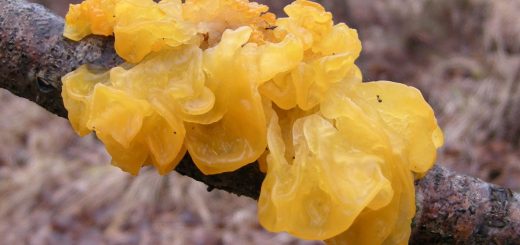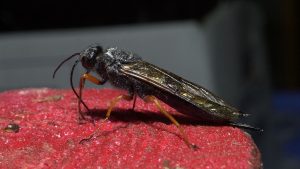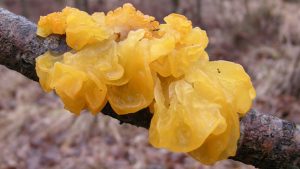#073: Overview of Mycorrhizae
Generally speaking, mycorrhizae are mutualistic interactions between the hyphae of a fungus and the roots of a plant. In most cases, the plant gives the fungus sugars in exchange for hard-to-get nutrients like nitrogen and phosphorous. Although there are exceptions to these rules, fungi that are described as “mycorrhizal” usually in the manner described above.
The word “mycorrhizae” (singular: “mycorrhiza”; adjective: “mycorrhizal”) literally means “fungus-root.” Associations between fungi and plant roots have been known about since the mid 1800’s, and the mutualistic nature of these symbioses was worked out in the 1880’s. The term “mycorrhiza” was first introduced in 1885 and originally referred to only mutualistic relationships in plant roots. It was later discovered that the same structures were used in parasitic interactions and were used on other (soil-contacting) parts of plants, so the definition had to be broadened to include these scenarios.* Although we have known about mycorrhizae for over a hundred years, we still know relatively little about them. Mycorrhizal fungi usually do not grow very well in a laboratory setting, so they are among the most difficult fungi to study. We know a lot about morphology and nutrient exchange, but we still cannot duplicate mycorrhizae in a laboratory setting.
Mycorrhizal fungi are probably the most economically important fungi, but not for the reasons you might expect. These fungi play a crucial—but usually overlooked—role in supporting many crop species. About 95% of all plant species form mycorrhizae with at least one fungus. These fungi allow plants to grow in nutrient-poor soils, increase the plants’ drought resistance, protect the plants from infection, and support seedlings. In fact, it has been demonstrated that most mycorrhizal plants could not survive without their fungal partners. Furthermore, mushroom-forming mycorrhizal fungi provide food for animals and sometimes humans. Truffles, morels, chanterelles, and Boletus edulis (Porcini or King Bolete or Penny Bun) are all mycorrhizal mushrooms and cannot be cultivated.
Despite the benefits of mycorrhizal associations listed above, plants sometimes choose not to form mycorrhizae. In fact, there are a few plants that never form mycorrhizae. Plants that grow in or on the water often do not form mycorrhizae. Those growing in extreme conditions (e.g.: sand dunes, the tundra, above the tree line, and in salty soils) also frequently resist the formation of mycorrhizae. Many mosses are non-mycorrhizal, but there are exceptions. Some plants that can grow non-parasitically on other plants (epiphytes), such as certain ferns, only form mycorrhizae when growing on the ground. There are also a few non-mycorrhizal crop species, including: the cabbage/mustard family,** beets, spinach, and lupins. Additionally, mycorrhizal plants may sometimes choose to block the formation of mycorrhizae. This usually happens when there is an abundance of nutrients. A high concentration of nitrogen and phosphorous in the soil allows plant roots to easily absorb these usually scarce nutrients. In this situation, the plant would be “paying” the fungus (in sugar) for something that the plant can get on its own. Instead of wasting its resources in this manner, the plant gets rid of its mycorrhizal partners.
So why do plants rely on fungi to get scarce nutrients? Fungal hyphae are much smaller than roots, so the combined surface area of the hyphal network is much greater than that of the root system. This makes it easier for the fungus to find and extract nutrients. Nonmycorrhizal plants overcome the problem of low surface area by modifying their root systems. These plants have very thin roots that are highly branched. Many of these species form “cluster roots,” which look like feathers or hairy pipe cleaners due to the densely-packed, short roots that are formed. You can tell how reliant a plant is on mycorrhizal fungi by looking at how highly branched its root system is. Large, woody organisms like trees tend to form sparsely-branched, thick roots and rely heavily on mycorrhizal partners. Annual, herbaceous plants tend to have highly branched, thin roots and are less reliant upon mycorrhizal fungi.
A complicating factor for understanding mycorrhizae is that each plant likely hosts more than one mycorrhizal fungus. Moreover, each fungus is likely hosted by more than one plant. This means that mycorrhizae actually form networks that can transport sugars, nutrients, and signaling compounds from one plant to another. There are a number of reasons this is important. First of all, it helps establish seedlings and protects the forest from non-native plants. Sugars from large trees can be fed to nearby seedlings via the mycorrhizal network, while non-native plants may not be able to tap into this carbon source. This gives the native plants a competitive advantage and helps maintain diversity in the forest. Second, plants that are parasitic on the mycorrhizal fungi are actually getting sugars from nearby trees via the mycorrhizae. This allows the fungus to stay alive even though one of its mycorrhizal partners is not providing it with food. Third, it was recently demonstrated that plants can warn nearby plants of danger (for example, of insect attack) through the mycorrhizal network.
Mycologists have debated for a long time over just how many types of mycorrhizae there are. Numbers tend to range from two to seven, with various sub-types included within these groups. For Fungus Fact Friday, I have chosen to break up mycorrhizae into four different groups based on both morphology and ecology: arbuscular mycorrhizae, ectomycorrhizae, orchidaceous mycorrhizae, and ericaceous mycorrhizae. The first two groups are relatively straightforward. Arbuscular mycorrhizae were once thought to be rare, but are now known to be the most common type of mycorrhizae. Fungi that form arbuscular mycorrhizae penetrate their host’s root cells and create characteristic branching structures. Ectomycorrhizae are more thoroughly studied than any other mycorrhizal group, mainly because the fungi involved often produce mushrooms and because the fungus can be seen growing on the root without needing to use a microscope. These fungal hyphae grow into the root itself and form net-like structures between the root cells but do not penetrate those cells. The remaining two groups are parsed out based on ecology rather than morphology. Orchidaceous mycorrhizae are formed with plants only of the orchid family. These mycorrhizae are unusual because the orchid is parasitic on its fungal partner and because the mycorrhizae may be formed in the stem of the orchid. The fungus penetrates the host plant’s cells and forms coils of hyphae. Ericaceous mycorrhizae include the few remaining types of mycorrhizae. All ericaceous mycorrhizae are formed with members of the plant family Ericaceae, which includes blueberries, rhododendrons, and heathers. These mycorrhizae grow inside cells, but may also grow around cells. One genus within the Ericaceae forms special mycorrhizae that are parasitic on the fungal partners.
It is important to note that some fungi will form different types of mycorrhizae depending upon the plant species with which the fungus is associated. This is especially true for parasitic mycorrhizae, where the fungus is usually involved in a separate mutualistic mycorrhizal association. This would seem to suggest that the plant controls the relationship. This is largely true, since under ideal conditions the plants can survive without the fungus, but the fungus usually cannot survive without the plant.*** Of course, many fungi only form mycorrhizae with specific hosts while others form mycorrhizae with a wide range of hosts. For example, Suillus pictus only grows in association with Eastern White Pine while the well-known Fly Agaric (Amanita muscaria) forms mycorrhizae with both coniferous and hardwood trees. An extreme example of fungal dominance in mycorrhizal relationships is the Death Cap, Amanita phalloides. Some mycologists have suggested that it has been so successful in colonizing North America because it is “cheating” in its mycorrhizae. By taking more than it gives to our naïve native trees, it can out-compete our balanced native fungi. This theory cannot be tested at present, which means we are missing a golden opportunity to expand our understanding of the mycorrhizal balancing act. These three examples demonstrate that although they may not be the dominant partner, fungi still have some control over the formation of mycorrhizae.
I will be explaining mycorrhizae in detail over the next four weeks, so keep up with Fungus Fact Friday if you want to learn more about these fascinating symbioses! Next week’s post will examine arbuscular mycorrhizae, the nearly ubiquitous mycorrhziae that went overlooked until recently.
* The description above is sufficient for the casual reader to get a good understanding of mycorrhizae. However, if you are interested, here is the technical definition of mycorrhizae (from http://mycorrhizas.info/index.html):
Mycorrhizae are symbiotic associations essential for one or both partners, between a fungus (specialized for life in soils and plants) and a root (or other substrate-contacting organ) of a living plant, that is primarily responsible for nutrient transfer. Mycorrhizae occur in a specialized plant organ where intimate contact results from synchronized plant-fungus development.
** The cabbage/mustard family (Brassicaceae) includes the crops: cabbage, Brussels sprouts, broccoli, cauliflower, kale, turnip, rape (which includes canola), mustard, radish, horseradish, wasabi, and watercress. The family also includes Arabidopsis thaliana, which is a very important model organism in the study of plants. [This list was compiled from Wikipedia and Encyclopædia Britannica.]
*** An exception to this rule is morels, which are mycorrhizal and saprobic at different parts in their life cycle. Oftentimes, a morel will not produce mushrooms unless its host tree has died. A number of Western North American morels are only found after forest fires have passed through.
See Further:
http://mycorrhizas.info/index.html
http://www.botany.hawaii.edu/faculty/wong/BOT135/Lect26.htm
http://website.nbm-mnb.ca/mycologywebpages/NaturalHistoryOfFungi/Mycorrhizae.html
http://aggie-horticulture.tamu.edu/faculty/davies/research/mycorrhizae.html
http://www.soilquality.org.au/factsheets/arbuscular-mycorrhizas-s-a
http://www.bbc.com/news/science-environment-22462855
Other information obtained from:
http://www.bayareamushrooms.org/mushroommonth/amanita_phalloides.html
http://www.britannica.com/EBchecked/topic/77928/Brassicaceae
http://en.wikipedia.org/wiki/Brassicaceae


![#059: Tremella mesenterica, Witch’s Butter [Archived]](https://www.fungusfactfriday.com/wp-content/themes/hueman/assets/front/img/thumb-medium-empty.png)





![#011: Characteristics of Kingdom Fungi [Archived]](https://www.fungusfactfriday.com/wp-content/themes/hueman/assets/front/img/thumb-small-empty.png)



2 Responses
[…] the ones that do not usually form ectomycorrhizas but a few plant families are nonmycorrhizal (see FFF#073 for more on other types of mycorrhizas). AM fungi tend to be generalists, colonizing a variety of […]
[…] fungi are critical for the health of trees (see FFF#073), but because of their elusive nature they are difficult to study in the environment. In a […]